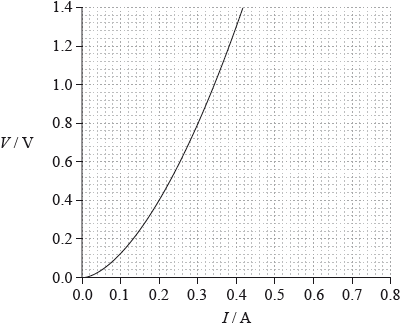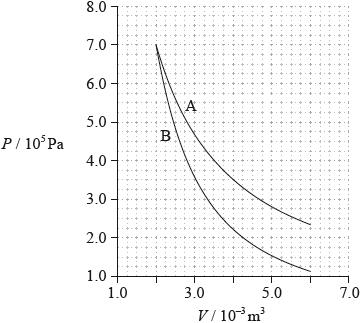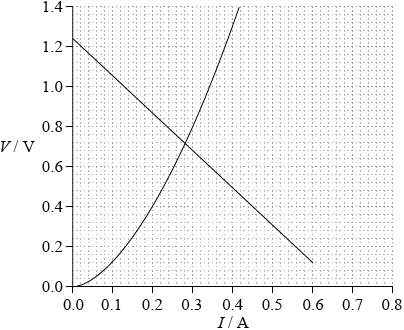| Date | November 2014 | Marks available | 2 | Reference code | 14N.2.HL.TZ0.8 |
| Level | Higher level | Paper | Paper 2 | Time zone | Time zone 0 |
| Command term | Explain and State | Question number | 8 | Adapted from | N/A |
Question
This question is in two parts. Part 1 is about internal resistance of a cell. Part 2 is about expansion of a gas.
Part 1 Internal resistance of a cell
The graph shows the voltage–current (\(V\)–\(I\) ) characteristics of a non-ohmic conductor.

The variable resistor in the circuit in (c) is replaced by this non-ohmic conductor.
Part 2 Expansion of a gas
Outline, with reference to charge carriers, what is meant by the internal resistance of a cell.
On the graph, sketch the variation of \(V\) with \(I\) for the cell.
Using the graph, determine the current in the circuit.
The graph shows how the pressure \(P\) of a fixed mass of gas varies with volume \(V\). The lines show the state of the gas sample during adiabatic expansion and during isothermal expansion.

State and explain whether line A or line B represents an adiabatic expansion.
Determine the work done during the change represented by line A.
Outline, with reference to the first law of thermodynamics, the direction of change in temperature during the adiabatic expansion.
Markscheme
charge carriers/electrons move through cell;
transfer energy to the components of the cell (which is not therefore available to external circuit);
energy dissipated in cell equivalent to dissipation in a resistance;
causes potential difference of cell to be less than its emf;
straight line of negative gradient; (allow any straight line of negative gradient)
intercept at \({\text{1.25 V (}} \pm 0.05{\text{)}}\) and position/gradient as shown;
Watch for ECF from (c)(iii).

uses a point at which lines intersect;
reads correct current value from their own graph;
\(0.28{\text{A}} \pm 0.1{\text{A}}\); (award for correct answer only)
\(PV\) is a constant for A / B is a steeper curve / final temperature/pressure lower for B than A;
(hence) B;
number of small squares below \({\text{A}} = 180 \pm 20\);
area of 1 square \( = 6.25{\text{ J}}\);
adds additional 64 squares below false origin;
answer within the range of 1400 to 1650 J; } (allow ECF for an area that excludes the area below the false origin – giving an answer within the range of 1000 to 1250 J)
Award [2] for a mean P of \(4.65 \times {10^5} \times \Delta V\) of \(4 \times {10^{ - 3}}\) giving an answer of 1860 (J).
Accept working in large squares (= 16 small squares) using equivalent tolerances.
no thermal energy enters or leaves / \(Q = 0\);
work done by the gas / \(W\) is positive;
so internal energy decreases / \(\Delta U\) is negative;
temperature is a measure of internal energy and so temperature falls;
Examiners report
This was a 3 mark question about internal resistance, so reasonable detail was expected. Candidates needed to refer to electrons/charge dissipating energy in moving through a cell and the effect on terminal potential difference.
Very few correct answers were seen. The equation of the line required is \(V = E - Ir\). Hence a line of negative gradient \({\text{(}}-{\text{1.9 }}\Omega )\) was required with a y intercept of 1.24 V.
If a candidate drew any kind of line, ECF was used when the coordinate of the intersection of the two lines was used to determine a current.
Most candidates were able to identify B as the adiabatic – either by referring to the gradients or lower pressures and temperatures compared to A, or by showing PV was constant for A but not B.
This was a 4 mark question and so candidates needed to give a detailed response. Many stated the 1st law, identified the three symbols and explained the change in each during an adiabatic expansion. Others were far less systematic. Most eventually predicted that temperature would decrease, but lost marks in their explanation.
This was a 4 mark question and so candidates needed to give a detailed response. Many stated the 1st law, identified the three symbols and explained the change in each during an adiabatic expansion. Others were far less systematic. Most eventually predicted that temperature would decrease, but lost marks in their explanation.

